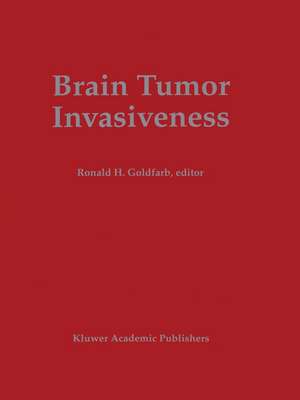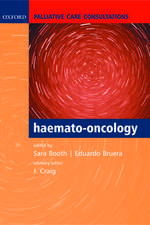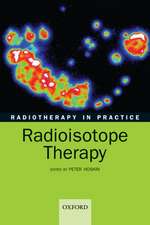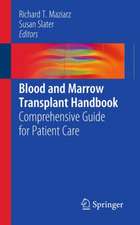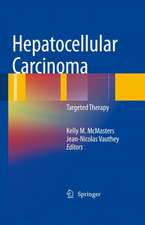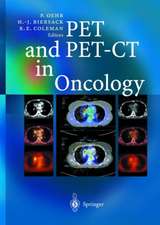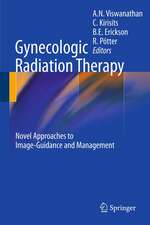Brain Tumor Invasiveness
Editat de Ronald H. Goldfarben Limba Engleză Paperback – oct 2012
This special issue of the JOURNAL OF NEURO-ONCOLOGY provides a state-of-the-art review of the general understanding of the process of tumor invasion. In addition, the articles emphasize specific aspects of aggressive brain cancers which are particularly important for deriving new insights for therapeutic approaches for advanced brain cancer that will target tumor invasiveness. The ideas discussed will stimulate further studies directed towards the translation of these important invasion-related studies to clinical approaches for the effective treatment of brain cancer.
| Toate formatele și edițiile | Preț | Express |
|---|---|---|
| Paperback (1) | 1279.72 lei 38-44 zile | |
| Springer Us – oct 2012 | 1279.72 lei 38-44 zile | |
| Hardback (1) | 1291.27 lei 38-44 zile | |
| Springer Us – 30 oct 1994 | 1291.27 lei 38-44 zile |
Preț: 1279.72 lei
Preț vechi: 1347.08 lei
-5% Nou
Puncte Express: 1920
Preț estimativ în valută:
244.90€ • 265.93$ • 205.72£
244.90€ • 265.93$ • 205.72£
Carte tipărită la comandă
Livrare economică 18-24 aprilie
Preluare comenzi: 021 569.72.76
Specificații
ISBN-13: 9781461361244
ISBN-10: 1461361249
Pagini: 92
Ilustrații: VIII, 82 p.
Dimensiuni: 195 x 260 x 5 mm
Greutate: 0 kg
Ediția:Softcover reprint of the original 1st ed. 1994
Editura: Springer Us
Colecția Springer
Locul publicării:New York, NY, United States
ISBN-10: 1461361249
Pagini: 92
Ilustrații: VIII, 82 p.
Dimensiuni: 195 x 260 x 5 mm
Greutate: 0 kg
Ediția:Softcover reprint of the original 1st ed. 1994
Editura: Springer Us
Colecția Springer
Locul publicării:New York, NY, United States
Public țintă
ResearchDescriere
It is widely appreciated that the pathophysiology of advanced brain cancer is intimately related to the extent of tumor invasiveness. A prerequisite for comprehensively understanding neuro-oncology is therefore the elucidation of the biochemical and molecular properties of tumor cells that contribute to their invasiveness. An understanding of tumor invasion for central nervous system tumors is crucial since malignant brain tumors are very highly invasive and extensively destroy adjacent neural brain tissue. Moreover, they are angiogenesis-dependent and lead to the death of patients by expanding within the limited space of the cranium. As more specific insights are gained towards a full understanding of the complex process of tumor invasiveness of brain tumor cells, it should be possible to design strategies for the early diagnosis and treatment of invasive, advanced brain tumors. There is therefore an urgent need to better understand the cellular properties of brain tumor cells responsible for invasiveness.
This special issue of the JOURNAL OF NEURO-ONCOLOGY provides a state-of-the-art review of the general understanding of the process of tumor invasion. In addition, the articles emphasize specific aspects of aggressive brain cancers which are particularly important for deriving new insights for therapeutic approaches for advanced brain cancer that will target tumor invasiveness. The ideas discussed will stimulate further studies directed towards the translation of these important invasion-related studies to clinical approaches for the effective treatment of brain cancer.
This special issue of the JOURNAL OF NEURO-ONCOLOGY provides a state-of-the-art review of the general understanding of the process of tumor invasion. In addition, the articles emphasize specific aspects of aggressive brain cancers which are particularly important for deriving new insights for therapeutic approaches for advanced brain cancer that will target tumor invasiveness. The ideas discussed will stimulate further studies directed towards the translation of these important invasion-related studies to clinical approaches for the effective treatment of brain cancer.
Cuprins
1. Tumor Invasion and Brain Cancer; R.H. Goldfarb, P.L. Kornblith. 2. Tumor Invasion, Proteolysis, and Angiogenesis; U.P. Thorgeirsson, C.K. Lindsay, D.W. Cottam, D.G. Gomez. 3. Matrix Degrading Metalloproteinases; B.W. Ennis, L.M. Matrisian. 4. Tumoral Invasion in the Central Nervous System; Y.A. De Clerck, H. Shimada, I. Gonzalez-Gomez, C. Raffel. 5. The Role of Tissue Inhibitor of Metalloproteinase-1 in Specific Aspects of Cancer Progression and Reproduction; R. Khokha, P. Waterhouse. 6. Role of Plasminogen Activator and of 92-KDa Type IB Collagenase in Glioblastoma Invasion using an in vivo Matrigel Model; J.S. Rao, P.A. Steck, P. Tofilon, D. Boyd, F. Ali-Osman, W.G. Steler-Stevenson, L.A. Liotta, R. Sawaya. 7. Malignant Melanoma Metastasis to Brain: Role or Degradative Enzymes and Responses to Paracrine Growth Factors; G.L. Nicolson, M. Nakajima, J.L. Herrmann, D.G. Menter, P.G. Cavanaugh, J. Sik Park, D. Marchetti. 8. Migration of Fresh Human Malignant Astrocytoma Cells into Hydrated Gel Wafers in vitro: Expression of p185c-neu; J.G. Bernstein, W.J. Goldberg, E.R. Laws, Jr. 9. Comparative Aspects of Neoplastic Invasion of the Brain; H.E. Kaiser.
